Archives
-
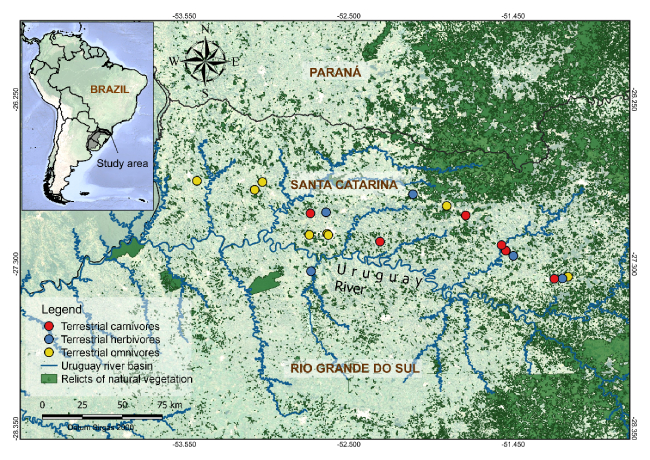 Vol. 17 No. 6 (2022)
Vol. 17 No. 6 (2022)
This research was conducted in Southern Brazil to determine the wildlife dynamic in a highly human-modified landscape using Oxygen-18. The map shows the location of samples of terrestrial carnivores, herbivores, and omnivores collected for analysis. The isotopic analysis showed that wildlife depends on artificial water reservoirs for their drinking habits. This emphasizes the need to improve sanitary control of these manmade ponds to protect natural fauna in the study region.
Source: CARBONERA, M. et al. The role of the artificial ponds for the conservation of mammals in the state of Santa Catarina. Rev. Ambient. Água, Taubaté, vol. 17 n. 6, p. 1-11, 2022. doi:10.4136/ambi-agua.2857
-
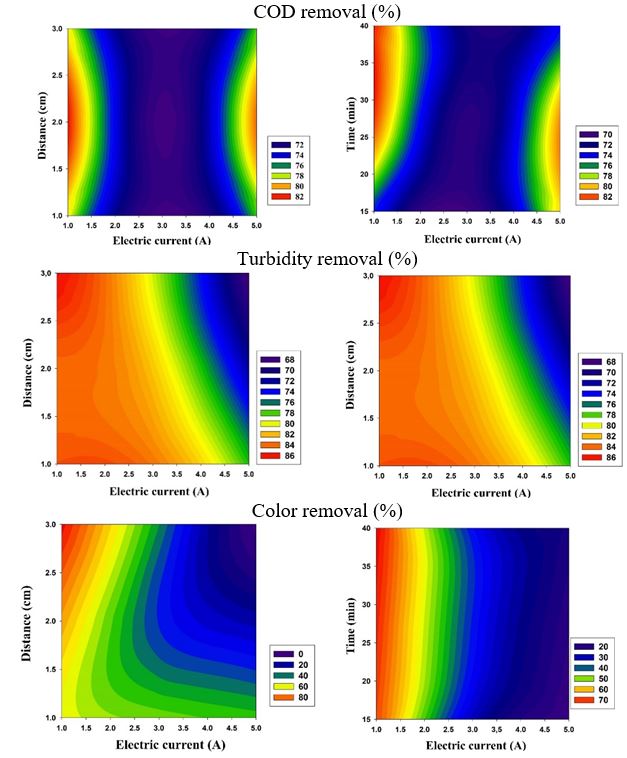 Vol. 17 No. 5 (2022)
Vol. 17 No. 5 (2022)
Results from research designed to investigate the efficiency of electrocoagulation in removing COD, turbidity, and apparent color from healthcare waste (HCW), these graphs show the percent removal of these parameters as a function of electric current, electrode distance, and hydraulic retention time. One of the conclusions associated with these results is that the high removal of turbidity, COD, and apparent color showed that electrocoagulation was effective for treating gas scrubber effluents.
Source: SANTOS, M. A. dos. et al. Optimization of effluent treatment from healthcare waste incineration by electrocoagulation with iron electrodes. Rev. Ambient. Água, Taubaté, vol. 17 n. 5, p. 1-12, 2022. doi:10.4136/ambi-agua.2834
-
 Vol. 17 No. 4 (2022)
Vol. 17 No. 4 (2022)
This series of maps shows the enrichment, geoaccumulation, potential ecological risk, and distribution of metals results in the Aguada Blanca Reservoir in southern Peru. This reservoir is the main source of drinking water for more than one million people in the city of Arequipa. It can be observed that most of the elements present an increase in their concentrations as they approach the reservoir outlet, which could indicate water quality problems due to inappropriate sediment removal in the last 30 years.
Source: ESPIRILLA, A. T. et al. Distribution and assessment of the environmental risk of heavy metals in Aguada Blanca reservoir, Peru. Rev. Ambient. Água, Taubaté, vol. 17 n. 4, p. 1-16, 2022. doi:10.4136/ambi-agua.2838
-
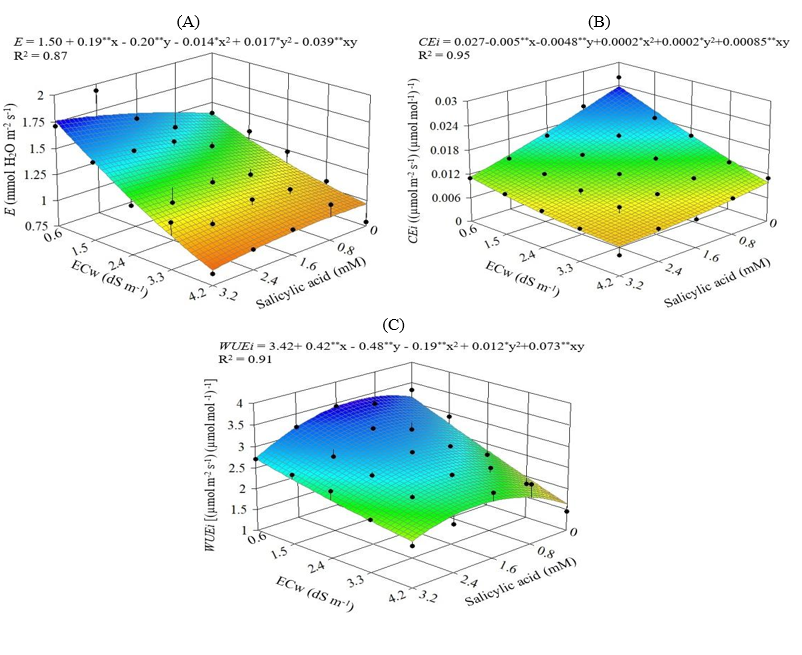 Vol. 17 No. 3 (2022)
Vol. 17 No. 3 (2022)
This figure shows some of the results obtained from research developed in the Northeastern region of Brazil aimed at evaluating the effect of foliar application of salicylic acid at different concentrations in mitigating the deleterious effects of salt stress on gas exchange, growth, and quality of 'Paluma' guava seedlings. Figures A, B, and C show response curves for transpiration - E (A), instantaneous carboxylation efficiency -CEi (B) and instantaneous water use efficiency - WUEi (C) as a function of the interaction between water salinity - ECw and salicylic acid - SA concentrations in guava.
Source: XAVIER, A. V. O. et al. Gas exchange, growth and quality of guava seedlings under salt stress and salicylic acid. Rev. Ambient. Água, Taubaté, vol. 17 n. 3, p. 1-17, 2022. doi:10.4136/ambi-agua.2816
-
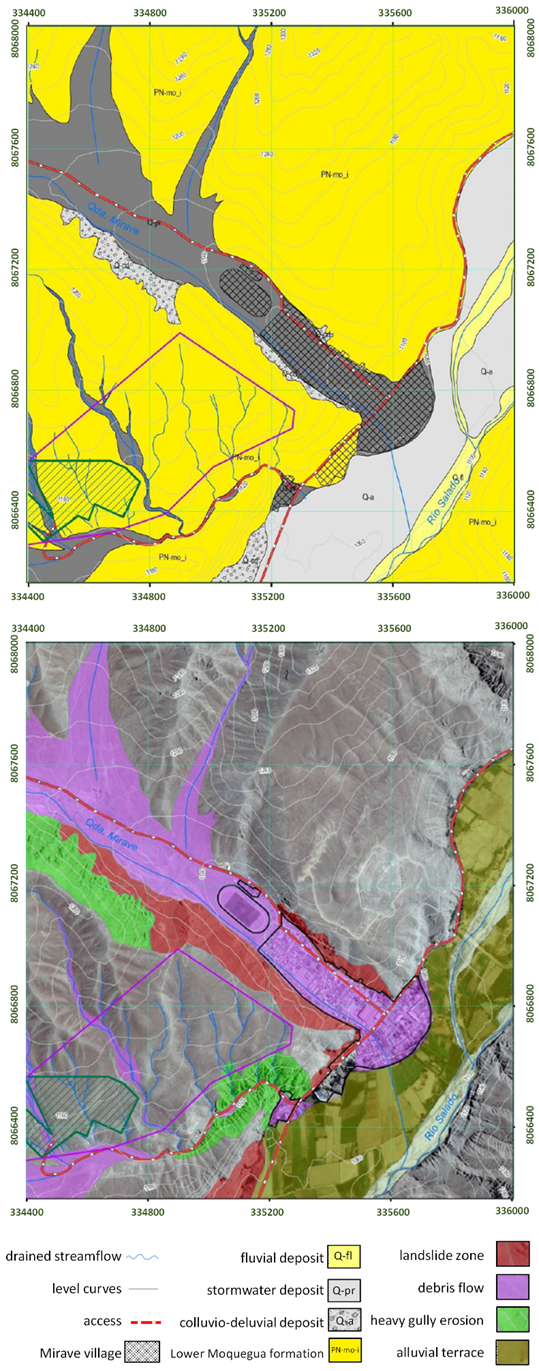 Vol. 17 No. 2 (2022)
Vol. 17 No. 2 (2022)
This map shows both geological features and hazards as a result of mass movements in the Mirave Basin, Peru, which is classified as a hyperarid environment. This lithological map shows the recent alluvial and storm-water deposits resulting from debris flow. In this study, the evaluation of the source of debris flows in the Mirave Basin has identified that erosion processes on hillsides maximize geologic hazards and associated risks to human communities.
Source: ORTEGA, J. C. B. et al. Effect of lithological and geotechnical characteristics on the generation of debris flows in the arid basin of Mirave, Peru. Rev. Ambient. Água, Taubaté, vol. 17 n. 2, p. 1-18, 2022. doi:10.4136/ambi-agua.2785
-
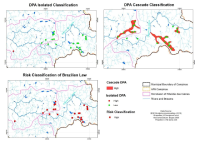 Vol. 17 No. 1 (2022)
Vol. 17 No. 1 (2022)
This study was intended to evaluate the risks of cascading dams in rural areas where they are commonly built to support irrigation, animal watering, or other purposes. These hydrological structures can cause significant damage when they collapse under heavy precipitation conditions. The figure shows the resulting classification from low to high Hazard Potential (DPA for its acronym in Portuguese) considering them isolated, under current Brazilian law, and the proposed Cascade Classification. The results emphasize the need for a preliminary safety assessment of the dam with special attention to small dams in cascade since accidents in the smaller dams are usually not reported even though they occur more frequently. And only a few countries have specific legislation or criteria for evaluating the safety of these structures.
Source: LIMA, D. A. de. et al. Application of a simplified methodology for classification of small dams in cascade. Rev. Ambient. Água, Taubaté, vol. 17 n. 1, p. 1-11, 2022. doi:10.4136/ambi-agua.2790
-
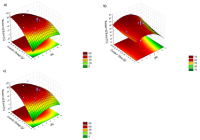 Vol. 16 No. 6 (2021)
Vol. 16 No. 6 (2021)
In this research, the use of laterite in natura for the removal of phosphorus in domestic effluents was investigated. The three parts of this graphic illustrate the interaction of the variables used in the study as follows: a) dosage of adsorbent material and pH; b) pH and contact time; and, c) dosage of adsorbent material and contact time in relation to the removal rate of phosphorus. The best adsorption occurred at pH 4 and other low pH values. High pH conditions affect the surface load of the adsorbent decreasing the adsorption rate. Laterite proved to be effective for the removal of phosphorus in synthetic effluents and can be used in filtering units to remove pollutants. Simplified techniques such as this can be used to meet the demand of the population without access to water treatment and distribution.
Source: SOARES, A.C.Da.S. et al. Low-cost material as active substrates for the removal of phosphorus in synthetic effluents: a proposal for social treatment technology. Rev. Ambient. Água, Taubaté, vol. 16 n. 6, p. 1-15, 2021. doi:10.4136/ambi-agua.2770
-
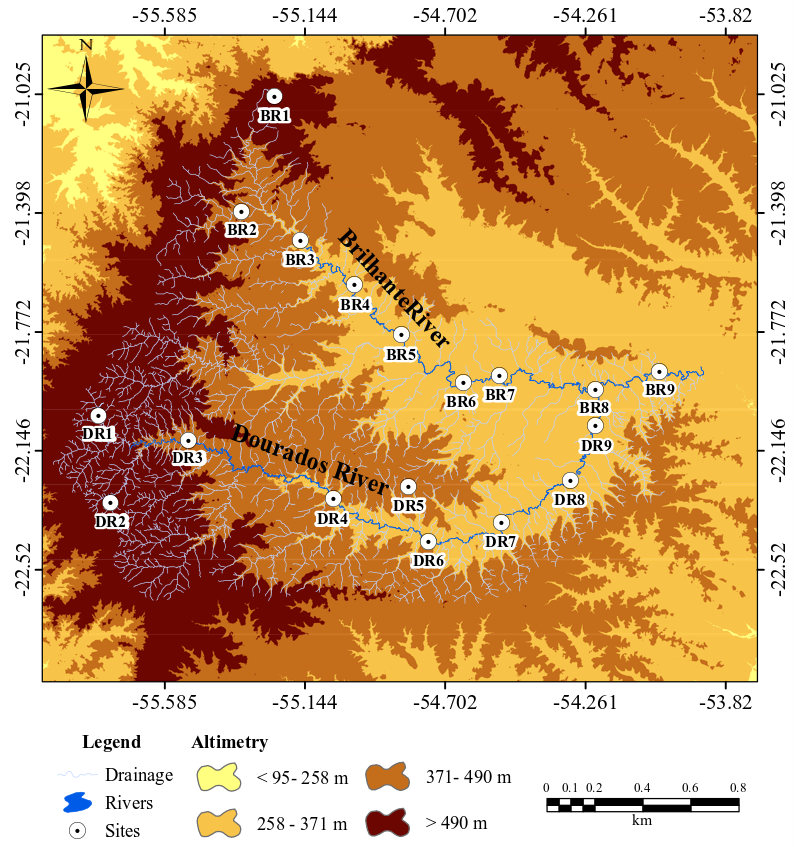 Vol. 16 No. 5 (2021)
Vol. 16 No. 5 (2021)
Iron concentration in water affects water biota and water quality as a whole. Human activity, landscape characteristics, and soil type are the main factors associated with iron bioavailability. The map above shows altimetry of Dourados and Brilhante rivers where considerable elevation change can be observed from both river headwaters increasing high iron concentration rock weathering. In this intense agriculture activity region native forest conservation practices are critical to revert water contamination with metals and reduce both water biota and human health risks.
Source: VIANA, L.F. et al. High iron content in river waters: environmental risks for aquatic biota and human health. Rev. Ambient. Água, Taubaté, vol. 16 n. 5, p. 1-20, 2021. doi:10.4136/ambi-agua.2751
-
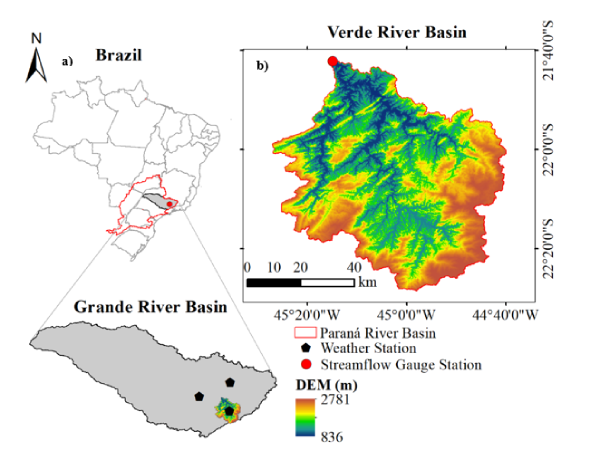 Vol. 16 No. 4 (2021)
Vol. 16 No. 4 (2021)
In this map there are three watershed limits highlighted that were the subject of research aimed at comparing climate change responses in the smaller unit known as Verde River Basin using two hydrological models: Variable Infiltration Capacity (VIC) and Soil and Water Assessment Tool (SWAT). This basin is the headwater of the Grande River Basin (GRB), southern Minas Gerais state, Brazil. Results indicate an overall consensus among all climate models of a projected maximum and minimum temperature increase in the study area.
Source: CARVALHO, V. S. O. et al. Impact of climate change on monthly streamflow in the Verde River Basin using two hydrological models. Rev. Ambient. Água, Taubaté, vol. 16 n. 4, p. 1-17, 2021. doi:10.4136/ambi-agua.2683
-
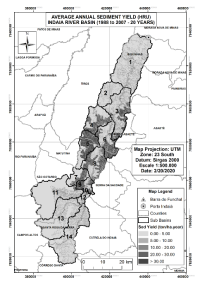 Vol. 16 No. 3 (2021)
Vol. 16 No. 3 (2021)
The map shows the average annual sediment yield map (ton/ha.year) of the Indaia river basin in Minas Gerais, Brazil. This research analyzed the sediment yield generated by water erosion in this basin from 1988 to 2017, applying the SWAT hydrological model. The results provided insights into identifying areas that contribute most to the sediment yield in the basin, that is, the source areas.
Source: SIMÕES, K. et al. Application of the SWAT hydrological model in flow and solid discharge simulation as a management tool of the Indaia River Basin, Alto São Francisco, Minas Gerais. Rev. Ambient. Água, Taubaté, vol. 16 n. 3, p. 1-18, 2021. doi:10.4136/ambi-agua.2694
-
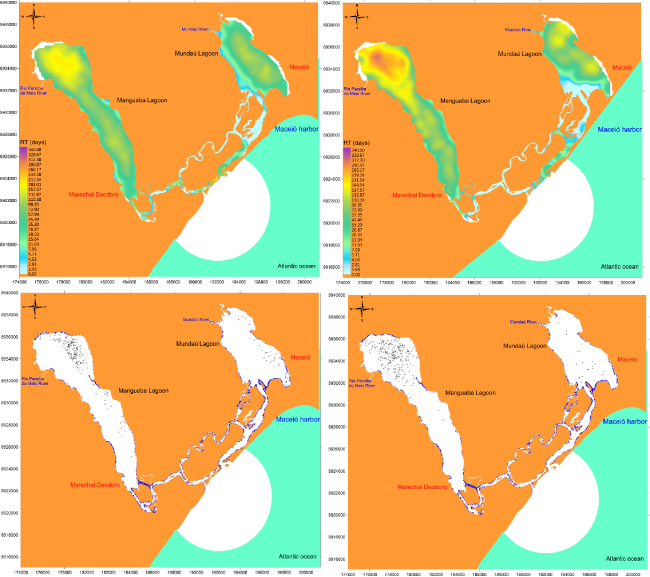 Vol. 16 No. 2 (2021)
Vol. 16 No. 2 (2021)
These maps show the residence time (RT) isolines in the Mundaú/Manguaba Lagoon Estuary Complex (CELMM), located on the coast of Alagoas state, Brazil. These isolines are associated with wind and freshwater discharge and affect water renewal processes as well as salinity levels and water temperature. As shown in the map, the region near the inlets and in the channel’s residence time was low and less than 10 days. In the back area of the lagoon, the residence time is high with a significant spatial variation. These areas of low circulation are important to identify since they are potentially susceptible to pollutant accumulation.
Source: CUNHA, C. L. N. et al. Effects on circulation and water renewal due to the variations in the river flow and the wind in a Brazilian estuary lagoon complex. Rev. Ambient. Água, Taubaté, vol. 16 n. 2, p. 1-18, 2021. doi:10.4136/ambi-agua.2600
-
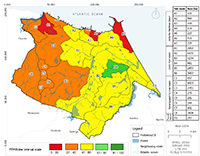 Vol. 16 No. 1 (2021)
Vol. 16 No. 1 (2021)
The Permanent Preservation Area (PPA) Water index is intended to assess the level of degradation of urban water resources. Its unique feature is not to employ water quality monitoring data, usually unavailable in developing countries. In contrast, it employs easy-to-apply innovative territorial information available in existing databases. The example presented in the map shows the result of PPA Water Index applied to the municipality of Fortaleza, CE, Brazil, categorized in five PPA management levels: Unconcerned (red), Inefficient (orange), Regular (yellow), Concerned (light green), and Efficient (dark green) management of PPAs.
Source: VASCONCELOS, F. D. M. et al. Quality index of permanent preservation areas of urban water resources: PPAWater. Rev. Ambient. Água, Taubaté, vol. 16 n. 1, p. 1-16, 2021. doi:10.4136/ambi-agua.2589
-
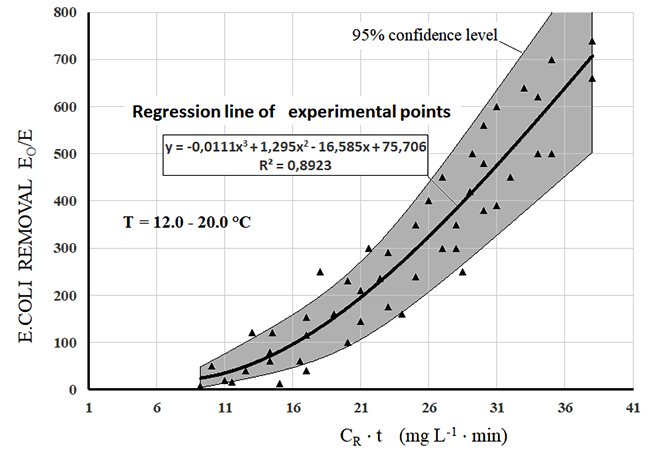 Vol. 15 No. 6 (2020)
Vol. 15 No. 6 (2020)
The results presented in this figure are based on research aimed at investigating the correlation between the disinfection performance with the factors contact time t and residual chlorine CR in a long period of time (2 years) enabling to provide insights into the possible effects of the different seasons and related climatic conditions over this process. More specifically, the figure shows the experimental correlation between the efficiency ratio of E. coli removal by disinfection (Eo/E) with the product of chlorine residual with the contact time (CR .t).
Source: BONI, M. R. et al. Study of the performance of disinfection with sodium hypochlorite on a full-scale sewage treatment plant. Rev. Ambient. Água, Taubaté, vol. 15 n. 6, p. 1-8, 2020. doi:10.4136/ambi-agua.2652
-
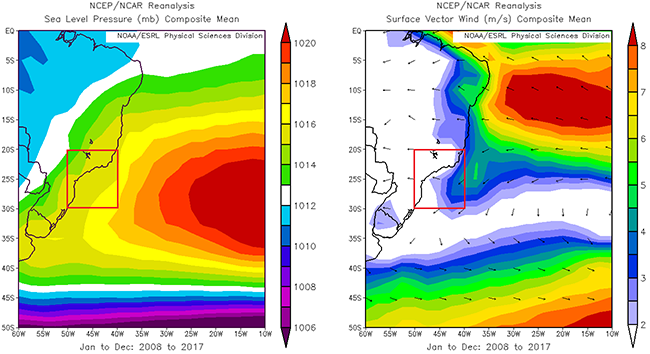 Vol. 15 No. 5 (2020)
Vol. 15 No. 5 (2020)
This figure shows the reduced pressure at sea level and surface wind climatology data (10-year mean) in the Brazilian coast as a component of a research that aims at showing the semi-systematic methodology to analyze aspects usually present in oil spill modeling and environmental impact assessment. The semisystematic approach seeks to identify and understand all potentially relevant research traditions that have implications for the studied topic, in this case, preventing the impacts of oil spill from offshore exploration in the Brazilian coast.
Source: ZACHARIAS, D.C. et al. Brazilian offshore oil exploration areas: an overview of hydrocarbon pollution. Rev. Ambient. Água, Taubaté, vol. 15 n. 5, p. 1-20, 2020. doi:10.4136/ambi-agua.2569
-
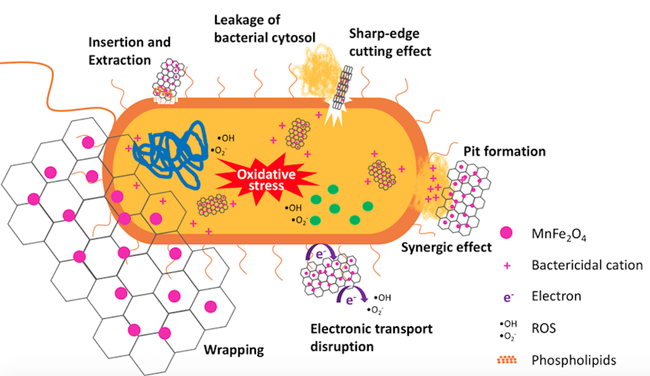 Vol. 15 No. 4 (2020)
Vol. 15 No. 4 (2020)
The figure shows the mechanisms associated with the synthesis of a nanocomposite of manganese ferrite graphene (MnFe2O4-G) that are likely to interact with Escherichia coli cell structures, resulting in damage and their death and, therefore, demonstrating its potential use in water and wastewater treatment processes. For more information on these six mechanisms please read the manuscript.
Source: SOLETTI, L.S. et al. Manganese ferrite graphene nanocomposite synthesis and the investigation of its antibacterial properties for water treatment purposes. Rev. Ambient. Água, Taubaté, vol. 15 n. 4, p. 1-12, 2020. doi:10.4136/ambi-agua.2515
-
 Vol. 15 No. 3 (2020)
Vol. 15 No. 3 (2020)
The graphs show the result of a mathematical model applied to estimate a better composition of fermentation medium to maximize lactase production by Saccharomyces fragilis IZ 275. These graphs show regions with maximum β-galactosidase activity associated with different combinations of cheese whey and sucrose, yeast extract and sucrose, peptone and sucrose, yeast extract and cheese whey, peptone and cheese whey, and peptone and yeast extract values. These results point toward two insights: (1) the variables studied are critical for lactase production by Saccharomyces fragilis IZ 275; and, (2) cheese whey, a by-product of the milk and dairy industry is an important medium for the growth of yeast.
Source: BOSSO, A. et al. Lactase production by Saccharomyces fragilis IZ 275 using different carbon sources. Rev. Ambient. Água, Taubaté, vol. 15 n. 3, p. 1-13, 2020. doi:10.4136/ambi-agua.2474
-
 Vol. 15 No. 2 (2020)
Vol. 15 No. 2 (2020)
This research intended to discuss methods to simulate characteristic hydraulic times (CHT) in a natural body with focus on Residence Time, Times of Renewal Rates and Water Age. The water body chosen is the Patos Lagoon located in southern Brazil considered the largest choked coastal lagoon in the world with over 300 km in length and an average width of 40 km. The figure shows the results of Water Age simulation for dry and wet seasons. The results show clearly the influence of river inflows in the northern part, and the influence of tides in the southern part.
Source: AGUILERA, L. et al. On characteristic hydraulic times through hydrodynamic modelling: discussion and application in Patos Lagoon (RS). Rev. Ambient. Água, Taubaté, vol. 15 n. 2, p. 1-20, 2020. doi:10.4136/ambi-agua.2456
-
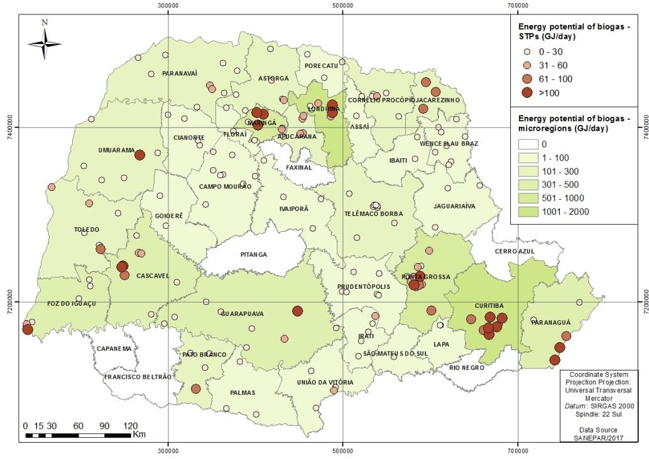 Vol. 15 No. 1 (2020)
Vol. 15 No. 1 (2020)
This map shows the distribution of biogas energy potentials for sewage treatment plants (STP) in the state of Paraná in the southern region of Brazil. The results of this research showed that 19 STP units presented a biogas energy potential above 100 GJ d-1 and 124 units a potential below 30 GJ d-1. The location of these units and associated biogas energy potential make it possible to assemble strategic plans for future investments in the energy recovery of the by-products of STPs.
Source: LOPES, L. S. et al. Energy potential of biogas and sludge from UASB reactors in the State of Paraná, Brazil. Rev. Ambient. Água, Taubaté, vol. 15 n. 1, p. 1-15, 2020. doi:10.4136/ambi-agua.2398
-
 Vol. 14 No. 6 (2019)
Vol. 14 No. 6 (2019)
The figure shows a shaded relief geological map of a portion of the Sanfranciscana Basin underneath which is located the Urucuia aquifer, the main focus of this research. In the figure, it is highlighted the area modeled with boundary conditions, climatological and groundwater observation stations, and stratigraphic wells. Based on the simulation of groundwater flow in steady-state, the results of this research point to a greater impact on surface water caused by a reduction in groundwater storage and related river base flow.
Source: OLIVEIRA, L. T. et al. Analysis of the long-term effects of groundwater extraction on the water balance in part of the Urucuia Aquifer System in Bahia - Brazil. Rev. Ambient. Água, Taubaté, vol. 14 n. 6, p. 1-15, 2019. doi:10.4136/ambi-agua.2390
-
 Vol. 14 No. 5 (2019)
Vol. 14 No. 5 (2019)
These maps show the distribution of heavy rainfall in Brazil based on a 5-year return period. These results were obtained from IDF (intensity-duration-frequency of heavy rain) relationships of gauge stations in the Brazilian territory. The map in the top left shows heavy rainfall with 5-minute duration. The one to the right shows 30-minute duration. The one at the bottom left shows 60-minute duration and the last one to the right 120-minute duration. According to these results, the highest values are concentrated in the Amazon region and in the southern part of the country and the lowest in the semi-arid region in the northeast. These estimates are important for the design of micro-drainage structures preventing them from being damaged by heavy rainfall events.
Source: SOUZA, G. R. de. et al. Heavy rainfall maps in Brazil to 5 year return period. Rev. Ambient. Água, Taubaté, vol. 14 n. 5, p. 1-10, 2019. doi:10.4136/ambi-agua.2403





